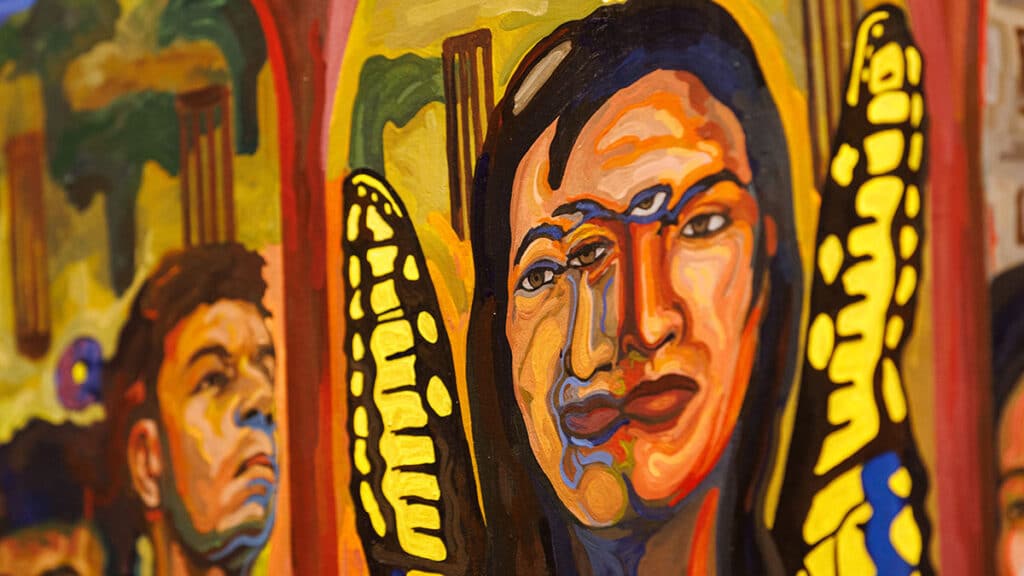Dominican Yorks is Hispanic Society’s reopening exhibition of New York Dominican artists in conversation with the library and museum’s art and rare books collection.
Dominican Yorks
Dominican Yorks is an art exhibition of work by three New York Dominican artists: Reynaldo García Pantaleón, Chiqui Mendoza, and Rider Ureña, in conversation with the museum’s collection; at Hispanic Society in Washington Heights, Manhattan; from February 23 to June 30, 2024. Free. hispanicsociety.org 🇩🇴
The Artists

Reynaldo García Pantaleón (1967) is a New York Dominican artist originally from Santo Francisco, Dominican Republic. His work is in the Smithsonian Collection. A New Yorker since 1995, García Pantaleón paints from his immigrant experience in New York with a bright Dominican palette. He titled his work “MiNacimiento (Ma Naissance)” in both Spanish and Haitian Kreyòl.
García Pantaleón’s use of multiple third eyes in the Indigenous Taíno character is a strong metaphor. When you are deeply connected with nature, you have a special kind of vision.
Chiqui Mendoza is a New York Dominican artist, originally from Santiago de los Caballeros, Dominican Republic. [Editor Keith: I’m writing this in Santiago.] Mendoza is inspired by Dominican Vodou. In the Dominican Republic, some call it Palo.
There is nothing bad about Vodou or Palo. Those scary stories were made up by American soldiers after the occupation of Haiti (1915-1934). People call Vodou folklore to diminish its religious status, but Vodou is a beautiful and highly developed religion, the equal of any other religion. [Editor Keith: I happen to be crowned Papa Legba, the saint of the truth.]
Mendoza works from the vevé, the Vodou or Palo graphics drawn with corn starch on the ground to call particular saints. Both Christians and Buddhists do similar spiritual drawings. They are very beautiful.
Mendoza is a brave artist. Many Dominicans look down on Vodou and Palo, even though many are Christian on Sunday, and Vodouisants, Paleros, or other traditional faiths, the rest of the time. Some use the folklore label to suggest the traditions are from the past, but the old ways live on in the Dominican Republic, a wonderful blend of rich and poor, past and future, and many different cultures. Mendoza is in the collection at Centro Leon, the main art museum and cultural center in Santiago. @chiquimendozastudio
Rider Ureña (1972) is a New York Dominican artist, also originally from Santiago de los Caballeros, the market city in the agricultural Cibao Valley. He also works from the Dominican Republic’s folkloric traditions. Ureña’s work is in the collection at Centro Leon, the main art museum and cultural center in Santiago. @riderurena
Spain and the Dominican Republic
Connecting Spanish and Dominican culture for the reopening of Hispanic Society is a clever choice. The oldest European city in the Americas is Santo Domingo, which was founded by Spanish colonizers in 1496. Spanish culture rooted deeply in the Dominican Republic. Even today many Dominicans will tell you that they are Spaniards ~ even if they are obviously have a more African or Indigenous heritage.
The Dominican Republic and New York City
Today Dominicans are New York City’s largest Latin community, but New York City, the city of immigrants, is itself Dominican from the very beginning. The first immigrant to what has become New York City was Juan Rodríguez from Santo Domingo. He was a Portuguese African from Santo Domingo, Dominican Republic and arrived on a Dutch ship in 1613.
Rodríguez didn’t want to go to Europe so he set up shop at the old Native American trading post where the New York branch of the National Museum of the American Indian is now.
Upper Broadway from 159th St in Washington Heights to 218th St in Inwood was renamed Juan Rodríguez Way by Mayor Bloomberg.
